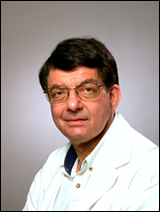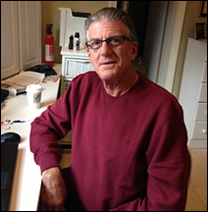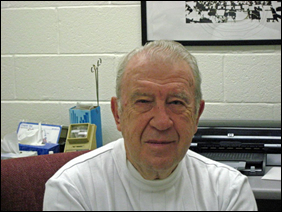Emeritus Members
I have been a member of the ATA for 42 years. I joined after my mentor at the NIH, Dr. Jan Wolff, suggested that I present my first paper on our studies of iodide transport at the 1966 ATA meeting. I concluded from that positive experience that this should be my scientific home because the authors of nearly all of the thyroid-related papers I had read were among its members. The major benefits of the ATA to me have been the stimulating papers devoted to my major research and clinical interests and the many lifelong friendships I developed with its members. Among these are included all of my scientific role models (Jan Wolff, Jack Robbins, Jack Oppenheimer, and Sidney Ingbar). My most memorable meeting, and among my most meaningful academic honors, was receiving the Van Meter prize in 1976. I have also been proud to relive that exciting moment on several occasions when individuals whom I have helped to mentor have received this same award. Over the years, I have enjoyed serving on a number of ATA committees, been a member of the Board of Directors and was honored to be its President in 1993-4. I have also received the Distinguished Service Award, the Parke-Davis Lectureship and the John B. Stanbury Pathophysiology Award. The Association has grown considerably since I first joined it and it has been very rewarding to see its success. The Scientific Programs continue to include original basic and clinical research always providing new insights about this important gland and its hormones in a remarkably collegial setting. The annual meeting of the ATA is the highlight of my year and I look forward to continuing my long-standing and rewarding association with this organization.
I have been with the ATA since September 30, 1971. I had begun to focus my interest in Thyroidology in the early 1970s because of my interest in measuring serum thyroid hormone levels by the latest radioimmunoassay technology. Early in my postgraduate training I was a Fellow in Thyroidology and actually presented a paper in 1961 in Philadelphia to the American Goitre Association (subsequently becoming the American Thyroid Association). The American Thyroid Association has become my favorite professional association because it had a congenial and very friendly membership which interacted with me and my wife, who also enjoyed coming to the meetings and was the basis for many wonderful friendships with other members and their spouses. The ATA has been a wonderful forum for presenting new findings and sharing ideas with other investigators. Previous ATA meetings along with my interactions with fellow ATA members have allowed me to develop my clinical and basic science career contributions in the field of Thyroidology. One of the most influential ATA persons was Boris Catz who acted as both a mentor and colleague as well as many others, including Arthur Bauman, Adolf Friedman, Jacob Lerman, Jerome Hershman and Inder Chopra. As a member of the ATA I was able to serve in the following capacities: Chairman of the Education Committee (1981-82), Member of the Finance & Audit Committee (1983-84), Chairman of Local Arrangements Committee at the 11th International Thyroid Congress, Toronto, Canada (1995), Chairman of the Nominating Committee (2002-03) Receiving the Paul Starr Award (2004), Sidney H Ingbar Distinguished Lectureship Award (2007), John B Stanbury Thyroid Pathophysiology Medal Award (2009) were some of the most memorable moments in the organization and my favorite ATA meeting was the 11th International Thyroid Congress, Toronto, Canada (1995). To all of the new and future members, joining this society is a wonderful way to stay abreast of current clinical and basic science advances in the field of Thyroidology. Moreover, your participation in the events of the Association will be very rewarding in many ways.
I am flattered and honored to contribute to December's Signal. Asking an endocrinologist for a short statement, or quick answer, is nearly impossible. I believe it is because endocrinologists, for the most part, enjoy what they do. This seems to be especially prevalent among those practicing thyroidology. We have a need to discuss concepts, treatment, and management paradigms that are forever changing. My interest in endocrinology and thyroid disease stems to my junior year in medical school. I still remember standing at the bedside of a patient with uncontrolled DKA. My attending at that time, Dr. Tom Huff, glanced at her and within moments said "just look at her, she's hyperthyroid and that is why her diabetes is so difficult to control." Within days of treating the hyperthyroidism, her diabetes improved and she was discharged. I was amazed the thyroid had such profound metabolic effects and decided then I was going to study endocrinology. I practiced endocrinology 35 years. However, I decided 25 years prior to retirement that I wanted to restrict my practice to disorders of the thyroid. These were the most exciting, and dynamic, years of my career. I enjoyed my practice and never considered that my health would force my retirement in 2008. Reminiscing about my practice, or even visiting my office, still evokes strong emotions. And only recently have I been able to accept not seeing patients and interacting with my ATA colleagues. I owe my joining the ATA to Dr. Lewis Braverman. We spent time together around 1979 or 1980 at an endocrine review course. He asked me what type of patient I enjoyed the most. When I responded thyroid, he told me in order to remain at the cutting edge of thyroid treatment I should join the American Thyroid Association. I did just that in the early 1980's and I learned more from the ATA than any other source during my years in practice. It did not take long for me to recognize that the ATA was going to structure thyroid management and provide the greatest resource for thyroid education, while opening doors to the finest thyroidologists nationally and internationally. I found I could call anyone with questions or observations and discuss cases as an equal. This is not a finding common to all specialties. It did not take long before I had concerned about the results of FNAs performed by non endocrinologists. I was always plagued by the high incidence of false positive and negative blind aspirations leading to unnecessary surgery. So to the consternation of many surgeons and radiologists, I learned how to perform my own in the mid 1980's. I was considered a heretic, as it was unconscionable that a non surgeon or radiologist should put a needle in the thyroid. As I began to compare the outside ultrasounds with the FNA cytology, I finding I often could not find a definite nodule on the ultrasound. I began to wonder if we were just needling nodular inflammatory changes. I purchased my own ultrasound and coerced the radiologist to teach me how to perform and interpret the US as well as perform an ultrasound guided FNA. Reluctant at first, they acquiesced when I reminded them of the number of nuclear treatments, ablations, CT, MRI, and PET scans we ordered. I thought is was more than a reasonable request. They came to see it that way too. I was initially blasphemed by even some of the older ATA members at the time. I was told palpation would suffice, an ultrasound was not really necessary and neither insurance or Medicare would cover it. They were correct in some cases; however, through organizations such as the ATA, and spreading the word by teaching local endocrinologists in Atlanta, house staff at Emory, and conducting classes at local, regional, and national ATA, and AACE meetings, we were able to promote the ultrasound guided FNA and the use of the ultrasound in follow up as the standard of care. Of all my organizations to which I was a member, I always felt the ATA represented a large national and international family, whose members are always there for you, freely picking up the phone to chat. In this era, chatting is an anachronism so we blog and email for support, and advice. The world of thyroidology has evolved, revolutionizing thyroid management, turning science and bench work into improved patient care. Were it not for the American Thyroid Association and the untiring efforts of thousands, we may not have evolved to such an extent, or as rapidly, as we have over the past 30 years. Endocrinologists would still be viewed as the lab bench geeks. It would not be fair to single out a single ATA mentor since I think I communicated with almost everyone over the years. I always considered my colleagues my friends and I can state unequivocally that every ATA meeting was the highlight of my academic and practice year. Meetings are always at exciting locations and always allowed schedule time to mix business with pleasure. Because speakers were generally the top in their field, I seldom left the meetings. Therefore, my wife, who seldom traveled to other medical or endocrine meetings, generally came with me. She knew I would spend most of my time at the meetings or reviewing abstracts, leaving her on her own without my bugging her not to shop. I have an abounding amount of advice for new ATA members. Go to every meeting, read the ATA publications, call authors, and colleagues liberally, remain open to change, feel comfortable telling patients what you learn at ATA meetings as relates to them and changing treatments. They feel rewarded when you think about them and your plans to update them with the newest in medications, diagnostics, genetics, cytology, labs, etc. Remember we are doctors, not technicians. Read "The Quotable Osler" repeatedly as a reminder we are not just here to feel the thyroid and biopsy nodules. Sir William Osler emphasized the importance of sitting down while asking patients' how they feel, even if it takes a few minutes more, it adds a mountain of information, respect, and trust. When my son entered medical school people asked me why would I let him do such a thing. I simply replied it is the greatest thing one can do. I think you will find this attitude pervasive among the ATA members. Treating thyroid disorders makes people feel better, saves lives, and brings smiles. I miss it, and would do it again without hesitation, if I could.
I've been a member since 9/30/1965 when I started my post medical studies and after my service in WWII. I was proud to join the ATA because of its elitist status that required my prior research publications as well as recommendations by distinguished members. These were by Drs. John Dunn, Mary Dratman, James Leathem and Sidney Ingbar. These scientists were my mentors. I had joined Dr. Dunn in the International Council for the Control of Iodine Deficiency Disorders (ICCIDD) in the World Health Organization (WHO). I remained loyal to the organization serving on the Board, WHO, and meeting committees. My basic specialty was Obstetrics and Gynecology and I served as the representative from both ACOG and the Endocrine Society. My major clinical and basic research interests are the relationships of the thyroid and iodine metabolism in reproduction and oncology (primarily breast). ATA has been valuable to me as I was presenting as the singular OB/GYN in the ATA. These researches that I presented to the ATA were important for my professional role and career. My most influential ATA contact and mentor was John Dunn who helped me present and describe my work as well as emphasize the important influence of the thyroid in reproduction as noted in the collection of textbooks that I have written on the subject. My favorite meeting was when I was selected as moderator for the 'importance of the thyroid and iodine metabolism in reproduction and health in women'. Unfortunately these topics have become less prominent to ATA meetings but are shared with the Endocrine Society. However, as I continue to work at Drexel University College of Medicine, new areas such as thyroid activities and aging in women has grown especially at the ATA. A word of advice to the new ATA members would be to recognize the value of the thyroid in multiple areas that are unique and which provides multiple avenues of study; techniques and clinical translations, featuring your own hypotheses. You must provide mentoring to the next generation of ATA members to continue the exciting interests that the thyroid and its pathways provide. |

 P. Reed Larsen, MD
P. Reed Larsen, MD Paul G. Walfish, MD
Paul G. Walfish, MD Victor E. Silverman, MD
Victor E. Silverman, MD Bernard A. Eskin, MD
Bernard A. Eskin, MD